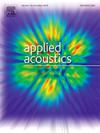Experimental study on noise reduction of a compact axial fan with leaned vanes
IF 3.4
2区 物理与天体物理
Q1 ACOUSTICS
引用次数: 0
Abstract
In this paper, the blade lean design was applied to a 1.5-stage compact axial fan, and its acoustic benefits were fully investigated through a reliable experimental study under five different rotation speeds with the tip Mach number ranging from 0.15 to 0.195. Compared with the original design, three additional sets of positively leaned vanes were employed for these test series. The far-field directivity and spectra analyses were conducted with the objective of investigating different acoustic behaviors in the upstream and downstream fields. Detailed experimental results show that each blade lean design, with negligibly affecting the aerodynamic performance, has achieved both the tonal and broadband noise reduction at all far-field observation angles over the range of rotation speeds. Evaluating different noise components, the relationship between the blade lean angle and noise reduction has been identified. It is found that the broadband noise reduction exhibits a positive correlation with blade lean angle, while the tonal noise reduction appears to have an optimal blade lean design. In summary, an overall sound power level reduction up to 5 dB in the upstream field and 3 dB in the downstream field has been achieved through these leaned vanes.
求助全文
约1分钟内获得全文
求助全文
来源期刊

Applied Acoustics
物理-声学
CiteScore
7.40
自引率
11.80%
发文量
618
审稿时长
7.5 months
期刊介绍:
Since its launch in 1968, Applied Acoustics has been publishing high quality research papers providing state-of-the-art coverage of research findings for engineers and scientists involved in applications of acoustics in the widest sense.
Applied Acoustics looks not only at recent developments in the understanding of acoustics but also at ways of exploiting that understanding. The Journal aims to encourage the exchange of practical experience through publication and in so doing creates a fund of technological information that can be used for solving related problems. The presentation of information in graphical or tabular form is especially encouraged. If a report of a mathematical development is a necessary part of a paper it is important to ensure that it is there only as an integral part of a practical solution to a problem and is supported by data. Applied Acoustics encourages the exchange of practical experience in the following ways: • Complete Papers • Short Technical Notes • Review Articles; and thereby provides a wealth of technological information that can be used to solve related problems.
Manuscripts that address all fields of applications of acoustics ranging from medicine and NDT to the environment and buildings are welcome.
 求助内容:
求助内容: 应助结果提醒方式:
应助结果提醒方式:


